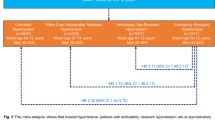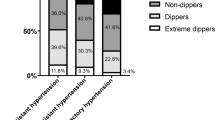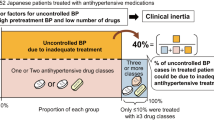Abstract
Refractory hypertension (RfHT) is an extreme phenotype of resistant hypertension (RHT) and is considered uncontrolled blood pressure (BP) despite the use of five or more antihypertensives. The objective of this study was to characterize the prevalence and clinical profile of RfHT patients in a historical cohort of patients with RHT at two different times: before and after the introduction of spironolactone. First, this cross-sectional study evaluated 1048 RHT patients (72.3% females, mean [SD] age: 61.2 [11.3] years) referred to a hypertension clinic (prespironolactone period). All patients were submitted to a standard protocol including clinical and complementary exams. Second, the analysis evaluated patients after the introduction of spironolactone (postspironolactone period). Statistical analysis included bivariate comparisons between patients with RHT and patients with RfHT and logistic regressions to assess the independent correlations of RfHT. A total of 146 patients (13.9%) remained refractory despite the use of at least five antihypertensives (prespironolactone period). After the introduction of spironolactone, the prevalence increased to 17.6%. For any criterion, RfHT patients were younger and more obese. In the initial period, current smoking and left ventricular hypertrophy were independently correlated with RfHT. Furthermore, after spironolactone use, RfHT patients had lower aortic stiffness and peripheral artery disease (PAD), pointing to a lower cardiovascular risk despite the lack of BP control. Younger age and lower prevalence of PAD correlated independently with RfHT. In conclusion, there was a high prevalence of RfHT, especially in younger and obese patients, and spironolactone use seemed to reduce cardiovascular risk despite the lack of BP control.
This is a preview of subscription content, access via your institution
Access options
Subscribe to this journal
Receive 12 digital issues and online access to articles
$119.00 per year
only $9.92 per issue
Buy this article
- Purchase on Springer Link
- Instant access to full article PDF
Prices may be subject to local taxes which are calculated during checkout

Similar content being viewed by others

References
Calhoun DA, Booth JN, Oparil S, Irvin MR, Shimbo D, Lackland DT, et al. Refractory hypertension: determination of prevalence, risk factors, and comorbidities in a large, population-based cohort. Hypertension. 2014;63:451–8.
de la Sierra A, Segura J, Banegas JR, Gorostidi M, de la Cruz JJ, Armario P, et al. Clinical features of 8295 patients with resistant hypertension classified on the basis of ambulatory blood pressure monitoring. Hypertension. 2011;57:898–902.
Daugherty SL, Powers JD, Magid DJ, Tavel HM, Masoudi FA, Margolis KL, et al. Incidence and prognosis of resistant hypertension in hypertensive patients. Circulation. 2012;125:1635–42.
Armario P, Calhoun DA, Oliveras A, Blanch P, Vinyoles E, Banegas JR, et al. Prevalence and clinic characteristics of refractory hypertension. J Am Heart Assoc. 2017;6:e007365.
Modolo R, de Faria AP, Almeida A, Moreno H. Resistant or refractory hypertension: are they different? Curr Hypertens Rep. 2014;16:485.
Dudenbostel T, Acelajado MC, Pisoni R, Li P, Oparil S, Calhoun DA. Refractory hypertension: evidence of heightened sympathetic activity as a cause of antihypertensive treatment failure. Hypertension. 2015;66:126–33.
Velasco A, Siddiqui M, Kreps E, Kolakalapudi P, Dudenbostel T, Arora G, et al. Refractory hypertension is not attributable to intravascular fluid retention as determined by intracardiac volumes. Hypertension. 2018;72:343–9.
Carey RM, Calhoun DA, Bakris GL, Brook RD, Daugherty Sl, Dennison-Himmelfarb CR, et al. American heart association professional/public education and publications committee of the council on hypertension; councilon cardiovascular and stroke nursing; council on clinical cardiology; council on genomic and precision medicine; council on peripheral vascular disease; council on quality of care and outcomes research; and stroke council. Resistant hypertension: detection, evaluation, and management. A scientific statement from the American heart association. Hypertension. 2018;72:e53–90.
Williams B, Mancia G, Spiering W, Agabiti Rosei E, Azizi M, Burnier M, et al. 2018 ESC/ESH guidelines for the management of arterial hypertension: the task force for the management of arterial hypertension of the European society of cardiology and the European society of hypertension: the task force for the management of arterial hypertension of the European society of cardiology and the European society of hypertension. J Hypertens. 2018;36:1953–2041.
Bloch KV, Melo AN, de, Nogueira AR. Prevalence of anti-hypertensive treatment adherence in patients with resistant hypertension and validation of three indirect methods for assessing treatment adherence. Cad Saude Publica. 2008;24:2979–84.
Pratt-Ubunama MN, Nishizaka MK, Calhoun DA. Aldosterone antagonism: an emerging strategy for effective blood pressure lowering. Curr Hypertens Rep. 2005;7:186–92.
Whelton PK, Carey RM, Aronow WS, Casey DE Jr, Collins KJ, Dennison Himmelfarb C, et al. 2017 ACC/AHA/AAPA/ABC/ACPM/AGS/APhA/ASH/ ASPC/NMA/PCNA guideline for the prevention, detection, evaluation, and management of high blood pressure in adults: executive summary: a report of the American college of cardiology/American heart association task force on clinical practice guidelines. Hypertension. 2018;71:1269–324.
El Assaad MA, Topouchian JA, Darné BM, Asmar RG. Validation of the Omron HEM-907 device for blood pressure measurement. Blood Press Monit. 2002;7:237–41.
Jones CR, Taylor K, Chowienczyk P, Poston L, Shennan AH. A validation of the Mobil OGraph (version 12) ambulatory blood pressure monitor. Blood Press Monit. 2000;5:233–8.
Parati G, Stergiou G, O’Brien E, Asmar R, Beillin L, Bilo G, et al. European society of hypertension practice guidelines for ambulatory blood pressure monitoring. J Hypertens. 2014;32:1359–66.
Van Bortel LM, Laurent S, Boutouyrie P, Chowienczyk P, Cruickshank JK, De Backer T, et al. Artery society; European society of hypertension working group on vascular structure and function; European network for noninvasive investigation of large arteries. Expert consensus document on the measurement of aortic stiffness in daily practice using carotid-femoral pulse wave velocity. J Hypertens. 2012;30:445–8.
Acelajado MC, Pisoni R, Dudenbostel T, Dell’Italia LJ, Cartmill F, Zhang B, et al. Refractory hypertension: definition, prevalence, and patient characteristics. J Clin Hypertens. 2012;14:7–12.
Buhnerkempe MG, Botchway A, Prakash V, Al-Akchar M, Nolasco Morales CE, Calhoun DA, et al. Prevalence of refractory hypertension in the United States from 1999 to 2014. J Hypertens 2019;37:1797–804.
de Souza F, Muxfeldt E, Fiszman R, Salles G. Efficacy of spironolactone therapy in patients with true resistant hypertension. Hypertension. 2010;55:147–52.
Dudenbostel T, Siddiqui M, Gharpure N, Calhoun DA. Refractory versus resistant hypertension: novel distinctive phenotypes. J Nat Sci 2017;3:pii: e430.
Modolo R, de Faria AP, Sabbatini AA, Barbaro NR, Ritter AM, Moreno H. Refractory and resistant hypertension: characteristics and differences observed in a specialized clinic. J Am Soc Hypertens. 2015;9:397–402.
Clark D 3rd, Ahmed MI, Calhoun DA. Resistant hypertension and aldosterone: an update. Can J Cardiol. 2012;28:318–25.
Epstein M, Duprez DA. Resistant hypertension and the pivotal role for mineralocorticoid receptor antagonists: a clinical update 2016. Am J Med. 2016;129:661–6.
Sharman JE, Boutouyrie P, Laurent S. Arterial (Aortic) stiffness in patients with resistant hypertension: from assessment to treatment. Curr Hypertens Rep. 2017;19:2.
Kapelios CJ, Murrow JR, Nührenberg TG, Montoro Lopez MN. Effect of mineralocorticoid receptor antagonists on cardiac function in patients with heart failure and preserved ejection fraction: a systematic review and meta-analysis of randomized controlled trials. Heart Fail Rev. 2019;24:367–77.
Gupta A, Schiros CG, Gaddam KK, Aban I, Denney TS, Lloyd SG, et al. Effect of spironolactone on diastolic function in hypertensive left ventricular hypertrophy. J Hum Hypertens. 2015;29:241–6.
Cezar MD, Damatto RL, Pagan LU, Lima AR, Martinez PF, Bonomo C, et al. Early spironolactone treatment attenuates heart failure development by improving myocardial function and reducing fibrosis in spontaneously hypertensive rats. Cell Physiol Biochem. 2015;36:1453–66.
Ma J, Zhang H, Guo H, Xu Y. Effects of low-dose spironolactone combined with irbesartan on cardiac hypertrophy induced by pressure overload in rats. Am J Transl Res. 2014;6:809–19.
Muxfeldt ES, Salles GF. How to use ambulatory blood pressure monitoring in resistant hypertension. Hypertens Res. 2013;36:385–9.
Siddiqui M, Judd EK, Oparil S, Calhoun DA. White-coat effect is uncommon in patients with refractory hypertension. Hypertension. 2017;70:645–51.
Muxfeldt ES, Cardoso CRL, Salles GF. Prognostic value of nocturnal blood pressure reduction in resistant hypertension. Arch Intern Med. 2009;169:874–80.
Dineva S, Uzunova K, Pavlova V, Filipova E, Kalinov K, Vekov T. Comparative efficacy and safety of chlorthalidone and hydrochlorothiazide—meta-analysis. J Hum Hypertens. 2019;33:766–74.
Funding
This study was supported by research grants from the Conselho Brasileiro de Desenvolvimento Científico e Tecnológico (CNPq, Distrito Federal, Brazil) and Fundação Carlos Chagas Filho de Amparo à Pesquisa do Estado do Rio de Janeiro (FAPERJ, Brazil). The sponsors have no role in study design, data collection and analysis, results interpretation or in preparation, review, and approval of the manuscript.
Author information
Authors and Affiliations
Corresponding author
Ethics declarations
Conflict of interest
The authors declare that they have no conflict of interest.
Additional information
Publisher’s note Springer Nature remains neutral with regard to jurisdictional claims in published maps and institutional affiliations.
Rights and permissions
About this article
Cite this article
Chedier, B., Cortez, A.F., Roderjan, C.N. et al. Prevalence and clinical profile of refractory hypertension in a large cohort of patients with resistant hypertension. J Hum Hypertens 35, 709–717 (2021). https://doi.org/10.1038/s41371-020-00406-2
Received:
Revised:
Accepted:
Published:
Issue Date:
DOI: https://doi.org/10.1038/s41371-020-00406-2
This article is cited by
-
Refractory Hypertension: a Narrative Systematic Review with Emphasis on Prognosis
Current Hypertension Reports (2022)


